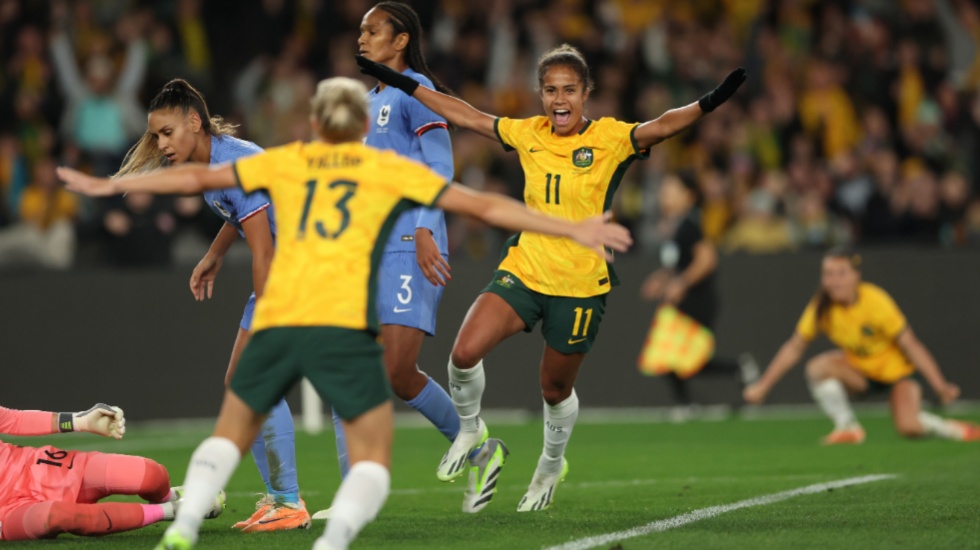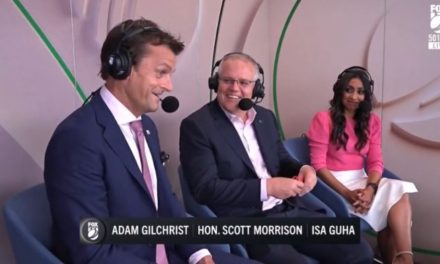Matildas forward Mary Fowler celebrates scoring a goal against France during a World Cup warm-up game at Marvel Stadium. Photo: GETTY IMAGES
Almost six years ago, I wrote a piece about the crowd for an Australian national women’s soccer match in Penrith.
The official attendance was 15,089 when the Matildas won a friendly against the well-fancied Brazil team in spectacular style.
The packed crowd was treated to a feast of quality football, with a highly-skilled strike by Lisa de Vanna and a glancing header by Sam Kerr, as Australia won 2-1.
And now look at the excitement the Matildas are drawing as Australia and New Zealand co-host the 2023 FIFA Women’s World Cup.
The tournament is the biggest event Australia has hosted since the pandemic and one of the biggest hosted since the Sydney Olympics in 2000.
Moreover, hosting it with our trans-Tasman cousins in New Zealand makes it extra special.
But what are the benefits of hosting major events? Are they worthwhile and long lasting? Or do they cost too much? After all, we had the case of the 2014 FIFA World Cup in Brazil, where new stadiums and airports were built in the Amazon only to lie idle after the tournament was over. And of course Sochi, where the Russian government overspent its planned budget to a show of force.
Could it be that only OECD economies can hold major sporting events? Or places like Qatar, host of last year’s FIFA World Cup, which have deep pockets thanks to its sovereign wealth fund?
In fact, Matt Carroll, CEO of the Australian Olympic Committee (AOC), explains the new candidature model of hosting under the International Olympic Committee (IOC)’s “New Norm” saves bidding expenses and countries (especially ones with limited resources) attempting to outbid each other.
“As much as possible you want the Olympics to be able to be hosted on existing infrastructure. That is the benefit of a place like Brisbane that has excellent sporting facilities, especially when you factor in the Gold Coast and Sunshine Coast as well,” he said.
That is why when two great cities Paris and Los Angeles both bid for 2024, the IOC negotiated for Paris to hold the 2024 Games and LA the 2028 Games, with Brisbane, from another OECD economy, following up as host in 2032.
The “New Norm” saves the situation of country bidding and missing out, building too much infrastructure that may become obsolete and having the overcommitment to the event being a drain on an economy already struggling to tackle poverty and the environment.
But Carroll also points out that the Olympics and the Commonwealth Games are important for ‘second-tier’ sports that don’t have the resources of the rugby league, Aussie rules, cricket, tennis and, increasingly, soccer.
“The Games matter for these sports, like hockey for example, that don’t have the commercial capacity of other larger codes. These sports are important grass roots sports with great followings in the suburbs and regional Australia,” he said.
So what are the benefits of this year’s FIFA Women’s World Cup?
There is the big economic splash, of course, with estimates from Football Australia (FA) of over $400 million in total benefits, including 3000 full time jobs and 60,000 visiting the country.
The expected benefits are in tourism and broadcast rights and as no new infrastructure was needed, required costs were kept down. Sharing the hosting rights with New Zealand meant a sharing of revenue but also kept the overhead costs down as well.
However, when the carnival is over, what will be the legacy beyond the boost in trade and tourism? FA has been thinking of the long-term benefits of co-hosting the World Cup with “Legacy23”.
PLEASE HELP US CONTINUE TO THRIVE BY BECOMING AN OFFICIAL FOOTYOLOGY PATRON. JUST CLICK THIS LINK.
Legacy23 is the FA’s plan to deliver immediate and long-term community benefits and economic impact derived from Australia co-hosting the World Cup. Legacy23 is particularly thinking about how to manage the expected surge in girls playing soccer inspired by the World Cup (and boys as well given the high-profile nature of the event).
“We are looking at 407,000 new participants coming into the game who are women and girls, so the real problem and an opportunity we have is that they’re going to need more places to play,” said Sarah Walsh, the FA’s head of women’s football, Women’s World Cup legacy and inclusion.
“We have over 2500 pitches and community clubs in Australia, but only one in five community clubs are actually female friendly. It’s a real concern and it’s a real opportunity that the legacy plan hopes to really correct and capitalise on.”
The expected surge in participation means that bread-and-butter improvements like better community facilities, change rooms and the like, are needed, especially ones that make it safer for girls to participate in soccer and other sports.
Finally, how much should we spend on elite versus community sport? This is a question for soccer as well as the Olympics in particular, but also all sports. After all, the competition for resources between elite sport and community participation has always been a delicate balancing act.
For example, in the Olympics, there is a focus on our champions winning gold medals, but we want the sports themselves to also thrive at the community level.
This has been front of mind for FA. For example, in the lead up to the World Cup, the Matildas have been awarded a brand new state-of-the-art training facility in Melbourne that only the Matildas can use. Therefore, Legacy23 attempts to balance this out, by emphasising facilities at the grass roots level.
This why the University of Technology Sydney (UTS), at the Centre for Sport, Business and Society, is investigating how greater participation in soccer, or any other active sport for that matter, helps to improve productivity and drive down health costs and related social expenditure.
There has to be lasting economic and social benefits shared across the community for the long term if a major event is to be deemed successful beyond the big splash of the year it is held.
After all, whilst we all love a Cathy Freeman, Sam Kerr or Steve Smith, we can’t have all our sports resources invested in the top one per cent of our talent.
There is no trickle down in sports economics, nor does it work in the wider economy. Hence, the policy framework that Legacy23 provides to boost the economic and social benefits of the World Cup across the community for decades to come.
As Walsh says: “An event without a legacy, is just an event. We need to leverage the momentum to make the World Cup last beyond just a few weeks in 2023.”
And on July 20th as the Matildas open the World Cup in front of a packed house of over 80,000 at Stadium Australia (co-hosts New Zealand are playing Norway on the same day in Auckland) it is sure going to feel like a long way away from drawing the 15,000-plus crowds in Penrith in 2017!
*Tim Harcourt is Industry Professor and Chief Economist at IPPG at University of Technology Sydney (UTS) and host of Footynomics – The Economics of Sport.
Do you want to study Sports Management at UTS? Check it out by clicking here.











